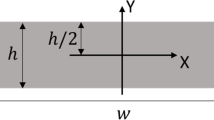Abstract
Short crack test specimens (a/W ≪ 0.50) are frequently employed when conventional deep crack specimens are either inappropriate or impossible to obtain, for example, in testing of particular microstructures in weldments and in-service structures containing shallow surface flaws. Values of elastic-plastic fracture toughness, here characterized by the crack tip opening displacement (CTOD), are presented for square (cross-section) three-point bend specimens with a/W ratios of 0.15 and 0.50 throughout the lower-shelf and lower-transition regions. Three dimensional, finite-element analyses are employed to correlate the measured load and crack mouth opening displacement (CMOD) values to the corresponding CTOD values, thus eliminating a major source of experimental difficulty in previous studies of shallow crack specimens. In the lower-transition region, where extensive plasticity (but no ductile crack growth) precedes brittle fracture, critical CTOD values for short crack specimens are significantly larger (factor of 2–3) than the CTOD values for deep crack specimens at identical temperatures. Short crack specimens are shown to exhibit increased toughness at the initiation of ductile tearing and decreased brittle-to-ductile transition temperatures. Numerical analyses for the two a/W ratios reveal large differences in stress fields ahead of the crack tip at identical CTOD levels which verify the experimentally observed differences in critical CTOD values. Correlations of the predicted stresses with measured critical CTOD values demonstrate the limitations of single-parameter fracture mechanics (as currently developed) to characterize the response.
Similar content being viewed by others
References
G. Matsoukas, B. Cotterell and Y.W. Mai, Journal of the Mechanics and Physics of Solids 34, No. 5 (1986) 499–510.
P.M.de Castro, J. Spurrier and P. Hancock, ASTM STP 677 (1979) 486–497.
J.D.G. Sumpter, International Journal of Pressure Vessel and Piping 10 (1982) 169–180.
B. Cotterell, Q.F. Li, D.Z. Zhang and Y.W. Mai, Engineering Fracture Mechanics 21, No. 2 (1985) 239–244.
Q.E. Li, Engineering Fracture Mechanics 22, No. 1 (1985) 9–15.
Q.F. Li, L. Zhou and S. Li, Engineering Fracture Mechanics 23, No. 5 (1986) 925–928.
D.Z. Zhang and H. Wang, Engineering Fracture Mechanics 26, No. 2 (1987) 247–250.
T.L. Anderson, H.I. McHenry and M.G. Dawes, ASTM STP 856 (1985) 210–229.
F. Ebrahimi, ASTM STP 945 (1988) 555–580.
W.A. Sorem, R.H. Dodds and S.T. Rolfe “An analytical comparison of short crack and deep crack CTOD fracture specimens of an A36 steel,” to appear in ASTM STP for the 21st national symposium on fracture mechanics.
W.A. Sorem, R.H. Dodds and S.T. Rolfe, “An analytical and experimental comparison of rectangular and square crack tip opening displacement fracture specimens of an A36 steel,” to appear in ASTM STP 995, American Society for Testing and Materials.
A.K. Shoemaker and R.R. Seeley, Journal of Testing and Evaluation 11, No. 4 (1983) 261–272.
R.H. Dodds and L.A. Lopez, International Journal for Advances in Engineering Software 2 No. 4 (1980).
R.H. Dodds and L.A. Lopez, International Journal for Engineering with Computers 13 (1985) 18–26.
M.G. Dawes, ASTM STP 668 (1979) 307–333.
G. Matsoukas, B. Cotterell and Y.W. Mai, International Journal of Fracture 26, No. 2 (1984) R49-R53.
R.H. Dodds, “Plastic rotation factors for shallow crack bend bars,” presented to ASTM Task Group E24.08.02 (Computational Techniques and Procedures), November 8, 1988, Atlanta, GA.
K. Wallin, Engineering Fracture Mechanics 19, No. 6 (1984) 1085–1093.
T.L. Anderson and S. Williams, ASTM STP 905 (1986) 715–740.
A.R. Rosenfield and D.K. Shetty, Engineering Fracture Mechanics 14, No. 4 (1981) 833–842.
J.D. Landes and D.H. Shaffer, ASTM STP 700 (1980) 368–382.
W.A. Logsdon, ASTM STP 590 (1976) 43–60.
W.A. Logsdon and J.A. Begley, ASTM STP 631 (1977) 477–492.
A. Al-Ani and J.W. Hancock, in Proceedings, 7th International Conference for Fracture, March, 1989, Houston, TX.
J.R. Rice and G.F. Rosengren, Journal of the Mechanics and Physics of Solids 16 (1968) 1–12.
J.W. Hutchinson, Journal of the Mechanics and Physics of Solids 16 (1968) 13–31.
I. Milne and G.C. Chell, ASTM STP 668 (1979) 358–377.
H.G. Pisarski, International Journal of Fracture 17 No. 4 (1981) 427–440.
R.O. Ritchie, J.F. Knott and J.R. Rice, Journal of the Mechanics and Physics of Solids 21 (1973) 395–410.
F. Ebrahmi, D.K. Matlock and G. Krauss, Scripta Metallurgica 16, No. 8 (1982) 987–992.
G. Green and J.F. Knott, Journal of Engineering Materials and Technology 98, Series H, No. 1 (1976) 37–46.
W. Weibull, Journal of Applied Mechanics 18 (1951) 293–297.
Author information
Authors and Affiliations
Rights and permissions
About this article
Cite this article
Sorem, W.A., Dodds, R.H. & Rolfe, S.T. Effects of crack depth on elastic-plastic fracture toughness. Int J Fract 47, 105–126 (1991). https://doi.org/10.1007/BF00032572
Received:
Accepted:
Issue Date:
DOI: https://doi.org/10.1007/BF00032572




